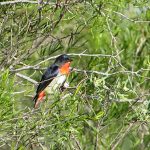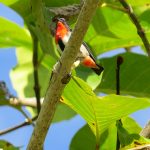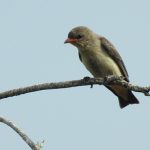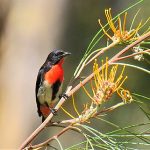MISTLETOEBIRD
Sharon: This little fella does a lovely courting dance to attract the females who are much plainer in colour. So Take a Peek to see him perform and see the nest the pair have built.
The Mistletoebird
- Size: Small, about 9–10 cm in length (that’s roughly the size of a Tim Tam biscuit!)
- Male plumage: Striking with glossy blue-black upperparts, a vibrant scarlet chest and rump, and white underparts
- Female plumage: More demure, with olive-grey upperparts, pale grey underparts, and a subtle red tinge on the rump
- Juveniles: Drab-grey, sometimes with hints of red on the rump, making them look like they’ve sat on a raspberry
Where Is It Found?
- Range: The Mistletoebird is native and widespread across most of mainland Australia, except for Tasmania and arid deserts.
- Habitat: Prefers open woodlands, forest edges, riverine thickets, and sometimes urban parks—wherever mistletoe abounds, really!
Breeding
- Breeding season: Mainly August to April, peaking in spring and summer
- Nesting: Females build pear-shaped, hanging nests from grass, bark, and spiderwebs, often camouflaged amongst foliage
- Eggs: Usually lays 3 to 4 eggs; incubation lasts about 10–12 days
- Parental care: Females incubate, but both parents feed the chicks. Fledging occurs around two weeks after hatching.
Longevity
- Average lifespan: Typically 4–6 years in the wild, though specifics are not thoroughly documented (their discreet nature makes tracking them tricky!)
Conservation Status
- IUCN status: Least Concern
- Australian status: Not threatened. Their adaptability and reliance on a widespread food source (mistletoe) keep their populations healthy.
The Mistletoebird’s Role in Nature
The Mistletoebird is an ecological courier specializing in “mistletoe mail”:
- Seed dispersal expert: It feeds almost exclusively on mistletoe berries, swallowing them whole. The seeds pass rapidly through its gut and are deposited in a sticky mess—perfectly packaged to adhere to tree branches. This helps new mistletoe plants germinate far and wide.
- Mutual benefit: While mistletoe is a parasite to trees, it creates mini-ecosystems, providing food and habitat for many species. The Mistletoebird ensures mistletoe’s success, and in turn, secures its own food source.
Interesting Facts
- Superfast digestion: Mistletoebirds can process a berry in about 4–25 minutes, optimised for seed dispersal.
- Specialist gut: Their digestive tract is uniquely short for rapid seed passage, ensuring seeds aren’t damaged.
- Inoffensive voice: Their call is a thin, high “tsit-tsit-tsit,” often inconspicuous amid the Aussie bush chorus.
- Resistant to poison: They can eat mistletoe berries that are mildly toxic to other animals.
- Not just a lovebird: Despite the romantic name, they rarely feature in festive traditions—they are named for their diet, not for their under-the-mistletoe charisma!
Summary Table
| Attribute | Details |
|---|---|
| Appearance | Small; M: blue-black & scarlet; F: grey-olive & red rump |
| Distribution | Mainland Australia wherever mistletoe grows |
| Habitat | Open woodland, forest edge, riverine vegetation, urban parks |
| Breeding | Nest: hanging pear-shaped; 3-4 eggs; both parents care |
| Lifespan | 4–6 years (estimated) |
| Conservation Status | Least Concern (IUCN) |
| Role in Nature | Specialist mistletoe seed disperser; supports woodland ecosystems |
| Fun Fact | Seeds go from gobble to poop in < 30 minutes! |
Mistletoes, Woodland Health, and Ecosystem Architects
Mistletoes are more than botanical freeloaders; they’re ecological powerhouses that play surprisingly influential roles in their environments. Let’s demystify their paradoxical (and somewhat misunderstood) place in the ecosystem.
Mistletoes and Woodland Health
What is Mistletoe?
- Mistletoes are hemiparasitic plants—meaning they photosynthesise (produce their own food) but also tap into host trees for water and nutrients via specialised roots called
haustoria. - Common species in Australia include
Amyema,Viscum, andLysiana.
Woodland Health Impacts: The Good, Bad, and Unexpected
1. Potential Negatives:
- Heavy infestations can weaken host trees, making them more susceptible to drought, disease, and wind damage.
- Occasionally, mistletoe overload can even kill host trees, especially those already stressed.
2. Ecological Positives (Here comes the twist!):
- Biodiversity Boosters: Mistletoes increase plant diversity, creating microhabitats for a wide range of organisms.
- Food Source: Flowers, fruits, and leaves of mistletoe are eaten by:
- Birds (like our friend, the Mistletoebird)
- Possums and gliders
- Insects (caterpillars, butterflies, and more)
- Shelter and Nest Sites: Their dense foliage provides prime nesting spots for birds and refuge for insects and small mammals.
- Nutrient Cycling: When mistletoe leaves fall, they decompose rapidly and enrich the soil, especially beneath trees where nutrients would otherwise be less concentrated.
3. Forest Health Balance:
- Most healthy, diverse woodlands can host some mistletoe without harm—problems typically arise in monocultures or degraded forests lacking natural control mechanisms (like browsing animals or wildfire).
Scientific Insight
Ecologists sometimes call mistletoes “keystone resources” because, despite being relatively rare (less than 1% of biomass), they support a disproportionately large number of woodland species.
Mistletoe as an Ecosystem Shaper
How Does Mistletoe Influence Broader Ecosystems?
1. Supporting Wildlife Richness
- Birds: Besides mistletoebirds, honeyeaters and lorikeets feed on nectar and fruit; some raptors nest in their clumps.
- Mammals: Gliders and possums munch mistletoe leaves and flowers, which can be more nutritious than the host’s own foliage.
2. Encouraging Complex Food Webs
- By attracting insects, mistletoes indirectly support insectivorous birds and mammals.
- Their berries and flowers make them seasonal resources—a lifeline during lean times.
3. Shaping Forest Dynamics
- Trees parasitised by mistletoe often die in parts, creating dead branches and hollows, which are vital for nesting fauna.
- Increased “structural complexity” (the mix of living and dead wood) helps foster a mosaic of habitats.
4. Cultural Use
- Indigenous Australians use mistletoe for food, medicine, and as part of cultural stories, recognising their importance for country long before science caught up!
A Little Analogy
Think of mistletoe as the unexpected party-guest who brings other interesting folk with them, ensuring that the woodland bash is lively and diverse, even if the host occasionally looks a bit ragged by dawn!
Summary Table
| Mistletoe Effects | Impact Area | Example |
|---|---|---|
| Parasitising trees | Tree health/structure | Dead branches, hollows |
| Food/Nourishment | Wildlife | Birds, mammals, insects |
| Habitat provision | Nest/shelter | Birds nest in dense mistletoe clumps |
| Nutrient cycling | Soil | Decaying leaves boost soil fertility |
| Biodiversity hotspot | Ecosystem level | More plant/animal/insect species present |
Quick Quiz – Myth or Fact?
Myth: Mistletoe is a woodland villain that should be removed. Fact: While problematic if overabundant, mistletoe is usually a sign of a healthy, functioning ecosystem and is crucial for many native species.




